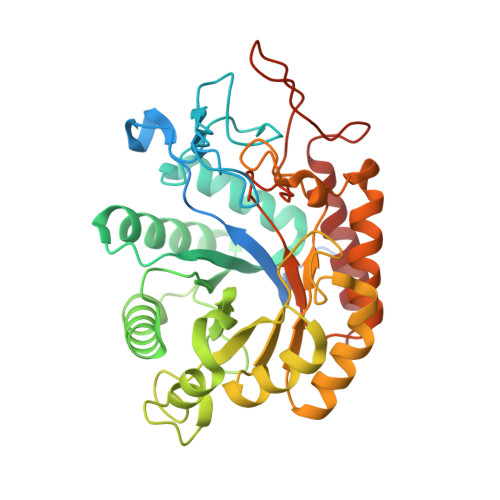Contribution of Shape and Charge to the Inhibition of a Family GH99 endo-alpha-1,2-Mannanase.
Petricevic, M., Sobala, L.F., Fernandes, P.Z., Raich, L., Thompson, A.J., Bernardo-Seisdedos, G., Millet, O., Zhu, S., Sollogoub, M., Jimenez-Barbero, J., Rovira, C., Davies, G.J., Williams, S.J.(2017) J Am Chem Soc 139: 1089-1097
- PubMed: 27992199
- DOI: https://doi.org/10.1021/jacs.6b10075
- Primary Citation of Related Structures:
5LYR, 5M03, 5M17, 5M3W, 5M5D, 5MC8, 5MEL - PubMed Abstract:
Inhibitor design incorporating features of the reaction coordinate and transition-state structure has emerged as a powerful approach for the development of enzyme inhibitors. Such inhibitors find use as mechanistic probes, chemical biology tools, and therapeutics. Endo-¦Á-1,2-mannosidases and endo-¦Á-1,2-mannanases, members of glycoside hydrolase family 99 (GH99), are interesting targets for inhibitor development as they play key roles in N-glycan maturation and microbiotal yeast mannan degradation, respectively. These enzymes are proposed to act via a 1,2-anhydrosugar "epoxide" mechanism that proceeds through an unusual conformational itinerary. Here, we explore how shape and charge contribute to binding of diverse inhibitors of these enzymes. We report the synthesis of neutral dideoxy, glucal and cyclohexenyl disaccharide inhibitors, their binding to GH99 endo-¦Á-1,2-mannanases, and their structural analysis by X-ray crystallography. Quantum mechanical calculations of the free energy landscapes reveal how the neutral inhibitors provide shape but not charge mimicry of the proposed intermediate and transition state structures. Building upon the knowledge of shape and charge contributions to inhibition of family GH99 enzymes, we design and synthesize ¦Á-Man-1,3-noeuromycin, which is revealed to be the most potent inhibitor (K D 13 nM for Bacteroides xylanisolvens GH99 enzyme) of these enzymes yet reported. This work reveals how shape and charge mimicry of transition state features can enable the rational design of potent inhibitors.
Organizational Affiliation:
School of Chemistry and Bio21 Molecular Science and Biotechnology Institute, University of Melbourne , Parkville 3010, Australia.





















